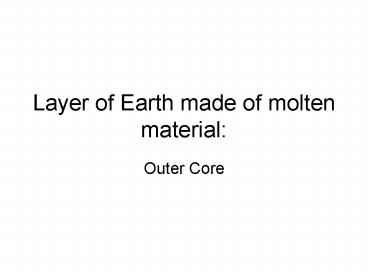Layer of Earth made of molten material: - PowerPoint PPT Presentation
1 / 27
Title:
Layer of Earth made of molten material:
Description:
Layer of the Earth that makes up the tectonic plates. ... This volcano is steep, explosive, has alternating layers of tephra & lava. Composite volcano ... – PowerPoint PPT presentation
Number of Views:67
Avg rating:3.0/5.0
Title: Layer of Earth made of molten material:
1
Layer of Earth made of molten material
- Outer Core
2
Layer of earth that is the largest.
- mantle
3
Layer of the Earth that makes up the tectonic
plates.
- Lithosphere (includes crust)
4
Layer of the earth that is plastic-like and
plates move on this layer.
- asthenosphere
5
This is the layer that is solid iron.
- Inner core
6
Where edges of plates meet are called the plate
___.
- Boundaries
7
Large fragments or breaks in a rock is called a
__.
- Fault
8
Where plates move apart the plates are called __.
- divergent
9
Where plates slide past each other they are named
__ plates
- transform
10
Plates that collide are called __ plates.
- convergent
11
Divergent plates
- Force acting on plates
- Formations made
- Earthquake that forms
- Tension
- Faults, fault-block mtn. Ocean ridges, ocean
rifts - Normal
12
Transform plates
- Force acting on plates
- Formations made
- Earthquake that forms
- Shearing
- Faults earthquakes
- Strike-slip earthquake
13
Convergent Plates
- Force acting on plates
- Formations made
- Earthquake that forms
- Compression
- Folded mtns.
- Reverse earthquake
14
When the Earths crust pushes up then __
mountains form
- Upwarped mountains
15
Volcanic mountains with gentle sloping sides are
caused by __.
- Hot Spots
16
How many seismographs will it take to identify a
location of an earthquake?
- 3
17
List the 3 seismic waves of an earthquake.
- Primary
- Secondary
- Surface waves
18
Which seismic wave is slowest but causes most
damage?
- Surface waves
19
Which seismic wave is fastest?
- Primary wave
20
Which seismic wave moves in the same direction as
the energy like a compressional wave?
- Primary wave
21
What do we call the point at which the earthquake
began?
- focus
22
Name the point above the focus on the earths
surface
- Epicenter
23
This is the largest volcano, it is very broad,
has thin, runny lava.
- Shield volcano
24
This volcano is steep, explosive, has alternating
layers of tephra lava.
- Composite volcano
25
This volcano will have a cone at top, releases
much gas, eruption is quick.
- Cinder cone
26
What is the cause of a tsunamis?
- Earthquake under water
27
What scale is used to measure the amplitude of a
seismic wave?
- Richter scale































